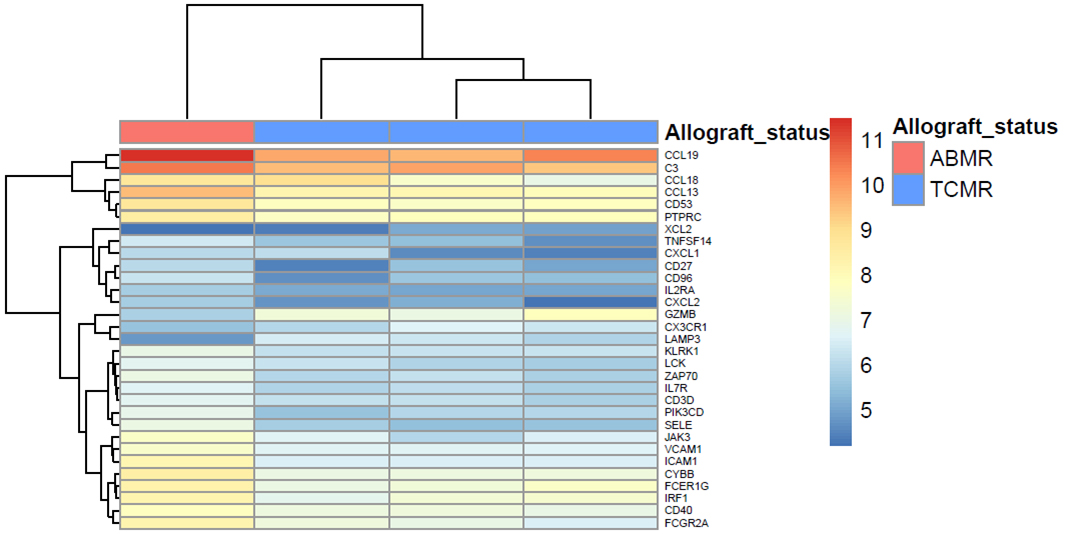Distinctive Molecular Features of Antibody-Mediated versus T-Cell Mediated Rejection in Facial Transplantation.
Brigham and Women's Hospital, Boston, MA
Meeting: 2017 American Transplant Congress
Abstract number: B292
Keywords: Antibodies, Gene expression, Rejection, T cells
Session Information
Session Time: 6:00pm-7:00pm
 Presentation Time: 6:00pm-7:00pm
Presentation Time: 6:00pm-7:00pm
Location: Hall D1
Background
A single case of antibody-mediated rejection in a clinical face transplant has been reported worldwide. The availability of repeated allograft biopsies from this patient allowed us to undertake a unique in-depth longitudinal examination of gene expression in the antibody-mediated rejection (AMR) episode and her subsequent T-cell mediated rejection (TCMR) episodes.
Methods
Cutting-edge NanoString gene expression platform was used to quantify the expression of 730 genes in facial allograft biopsies collected during AMR versus TCMR episodes, and compared with biopsies taken during five non-rejection timepoints. Data on pre- and post-transplant donor specific antibodies (DSA) was collected and flow cytometric analysis of peripheral blood was performed to examine the dynamics of B cells and T follicular helper cells (Tfh). Immunohistochemistry (IHC) was performed on selected specimens.
Results
Circulating DSAs became undetectable once AMR resolved, and remained negative during subsequent TCMR episodes. Flow cytometric analysis of Tfh and memory B cells in peripheral blood showed that both increased during AMR. Gene expression profiles suggest that there are distinctive molecular features in AMR compared to TCMR within the allograft [figure 1]. Genes that contribute most to the variability between AMR and TCMR have functions related to leukocyte trafficking (including ICAM-1) and cytotoxicity (including Granzyme B), a finding further validated by IHC, providing mechanistic insights into underlying effector mechanism.
Conclusions
Our findings raise the possibility that molecular diagnostics may complement clinical, serological and histological examination in diagnosing AMR in face transplants, and have wider implications to other vascularized composite allografts (VCAs). This is particularly important since current BANFF classification does not differentiate TCMR from AMR, C4d is not a reliable marker of AMR in VCAs and not all circulating DSAs are associated with AMR, which may lead to inaccurate diagnosis and treatment.
CITATION INFORMATION: Lopdrup R, Win T, Murakami N, Teague J, Chandraker A, Murphy G, Lian C, Bueno E, Pomahac B, Clark R, Riella L. Distinctive Molecular Features of Antibody-Mediated versus T-Cell Mediated Rejection in Facial Transplantation. Am J Transplant. 2017;17 (suppl 3).
To cite this abstract in AMA style:
Lopdrup R, Win T, Murakami N, Teague J, Chandraker A, Murphy G, Lian C, Bueno E, Pomahac B, Clark R, Riella L. Distinctive Molecular Features of Antibody-Mediated versus T-Cell Mediated Rejection in Facial Transplantation. [abstract]. Am J Transplant. 2017; 17 (suppl 3). https://atcmeetingabstracts.com/abstract/distinctive-molecular-features-of-antibody-mediated-versus-t-cell-mediated-rejection-in-facial-transplantation/. Accessed December 15, 2025.« Back to 2017 American Transplant Congress
